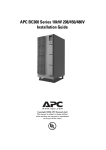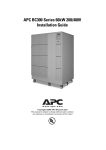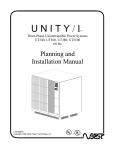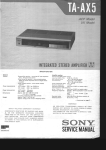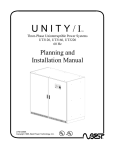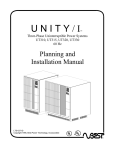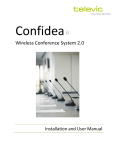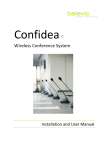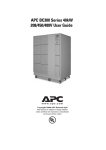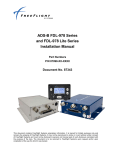Download APC BC300 Series Installation guide
Transcript
APC BC300 Series 15kW 208/450/480V Installation Guide Copyright ©2002 APC Denmark ApS This manual is subject to change without notice and does not represent a commitment on the part of the vendor Thank You Thank you for choosing the APC BC300 Series. Read this Installation Guide before you install and use the system as it provides important information on safe and efficient installation and use. The installation and use of this product must comply with national, federal, state, municipal and local codes. IMPORTANT SAFETY INSTRUCTIONS – SAVE THESE INSTRUCTIONS Safety Symbols used in this manual WARNING! Indicates a hazard which, if not avoided, could result in injury or death. CAUTION! Indicates a hazard which, if not avoided, could result in damage to the product or other property. NOTICE! Read and pay attention to this important information. ‘ WARNING This UPS unit contains hazardous AC and DC voltages. Only qualified electricians should connect the UPS, AC line and external batteries, and must be familiar with batteries and battery installation. Before installing, maintaining or servicing the UPS, shut off the UPS and disconnect all sources of AC and DC power. As the UPS has no built-in disconnection devices to switch off external AC and DC input power, ensure that disconnection devices are available as separate parts in connection with the installation. The installer must provide each external disconnecting device for this UPS system with labels with the following text: “Isolate the Uninterruptible Power Supply (UPS) as instructed in this guide before working on circuit”. AC and/or DC voltage will always involve a potential risk of AC voltage at UPS output generated from either batteries or utility. To avoid equipment damage or personal injury, always assume that there may be voltage at UPS output. This system is equipped with an auto-start function. If activated, the system may start without warning. Refer to the “Programming” section for information on de-activation. TEST BEFORE YOU TOUCH! To reduce the risk of fire or electric shocks, install the UPS and external batteries in a temperature and humidity controlled indoor area, free of conductive contaminants. UPS batteries are high-current sources. Shorting battery terminals, DC terminals or DC busbars can cause severe arcing, equipment damage and injury. A short circuit can cause a battery to explode. Always wear protective clothing and eye protection and use insulated tools when working on batteries. CAUTION! This unit contains components sensitive to electrostatic discharge (ESD). If you do not follow the ESD procedures, you may cause severe damage to electronic components. 990-1165 2 Installation Guide APC BC300 Series 15kW 208/450/480V UPS Contents: 1.0 2.0 3.0 Introduction 4 1.1 4 Receiving, Unpacking, Moving and Storing the UPS and Batteries 5 2.1 2.2 5 5 5.0 6.0 7.0 8.0 Receiving, Unpacking and Moving to Site Storing the UPS and Batteries Installation 3.1 3.1.1 3.2 3.2.1 3.2.2 3.2.3 3.3 3.3.1 3.3.2 3.3.3 3.3.4 3.3.5 3.3.6 3.4 3.4.1 3.4.2 4.0 Tools and Equipment Needed Requirements on Site UPS Footprint (measurements in inches & mm) Installing the Conduit Connection Kit Conduit Connection Kit Contents Installing Pedestals Installing Conduit Box and Base Covers Installing the Maintenance Bypass Panel and UPS Component Overview (door open) Wiring Terminations Wiring Diagram for BC300 Single Line Diagram for BC300 External Connection Board Communication Interface Board (Option) Installation of External Batteries and Battery Breaker Battery Installation Battery Replacement 6 6 7 8 8 9 9 9 15 16 18 19 23 24 25 25 27 Initial Start-up and Phase Check 28 4.1 4.2 28 29 Initial Start-up and Phase Check (Internal Batteries) Initial Start-up and Phase Check (External Batteries) Clearing the Events Log 31 Start-up and Shutdown Procedure 32 6.1 6.2 32 33 Start-up from Maintenance Bypass Shutdown Procedure Technical Specifications 34 7.1 7.2 7.3 34 36 36 APC BC300 Series 15kW Technical Data Battery Specifications Dimensions / Weight How to Contact APC 37 990-1165 Installation Guide APC BC300 Series 15kW 208/450/480V UPS 3 Introduction 1.0 Introduction This Installation Guide provides the electrician with information on UPS installation, wiring, start-up and shut-down procedures along with Maintenance Bypass Panel phase check and external battery installation. Electricians should always refer to national and local electrical codes prior to installing the UPS system. 1.1 Tools and Equipment Needed This section lists all tools and equipment required to connect the UPS to the Maintenance Bypass Panel. Insulated Tools and Other Equipment Needed: • Torque wrench in inch-pounds or newton-meters • Standard U.S. and metric wrenches • Petroleum jelly or conductive grease • Brush (for applying petroleum jelly or conductive grease to battery terminals) • Mallet • Volt-Ohm meter (True RMS - Digital) • Pliers • Ratchet and sockets • Electrical tape • Standard and Phillips screwdrivers • Torx head screwdriver set • APC BC300 User Guide • Phase rotation meter Cables and interconnection hardware not provided by APC. 990-1165 4 Installation Guide APC BC300 Series 15kW 208/450/480V UPS Receiving, Unpacking, Moving and Storing the UPS and Batteries 2.0 Receiving, Unpacking, Moving and Storing the UPS and Batteries 2.1 Receiving, Unpacking and Moving to Site CAUTION! Heavy equipment. To prevent personal injury or equipment damage, use caution when handling and transporting UPS cabinet and equipment. 1. While the UPS system is still on the truck, inspect the equipment and shipping container(s) for any signs of damage. Do not install the system if damage is apparent. If damage has occurred, notify APC as soon as possible. 2. Compare the shipment with the bill of lading. Report any missing items to the carrier and to APC immediately. 3. Remove the screws on the bottom part of the packaging side plates. 4. Remove the packing materials from the unit. 5. Verify compliance between type label on reverse side of UPS front door and system ordered. Check input and output voltage. 6. Unbolt the unit from the pallet. 7. Remove the unit from the pallet with a fork lift. 8. Use a fork lift or hand truck to transport the unit to the installation or storage site. Study the footprint to decide how to move the UPS through doorways and into position. PLEASE RECYCLE The shipping materials are recyclable. Please save for later use or dispose of them appropriately. 2.2 Storing the UPS and Batteries Store the APC BC300 Series UPS between -4 and 104° F (-20 and 40° C). However, APC recommends that the unit and batteries be stored between 59 and 77° F (15 and 25° C). This temperature range, or cooler, allows batteries a longer shelf life. Recharge stored batteries every 90 to 120 days. See the section “Requirements on Site” in this Installation Guide for further details. 990-1165 Installation Guide APC BC300 Series 15kW 208/450/480V UPS 5 Installation 3.0 Installation 3.1 Requirements on Site A 3-foot free space on all sides should be allowed during installation. Place the UPS in a clean, dust-free environment, free of contaminants. Allow air circulation around the UPS cabinet and any battery cabinets or racks. • Ambient temperature range: 32 to 104° F (0 to 40° C). Ideal temperature: 77° F (25° C) NOTE: At 92° F (33° C), battery life would be approx. 50% compared to storage at a normal temperature of 77° F (25° C). At 113° F (45° C). Battery life will be reduced to some 25%. Make sure that the floor can support the weight of the UPS, external batteries, and any other necessary equipment. • Never install systems in direct sunlight or near heat sources. • Service access from front and top of unit. Cable entry from bottom of unit. • Do not operate the UPS or batteries in a sealed room or container. NOTICE! Allow a minimum clearance of 3 foot (914mm) for service in front of and above the UPS and 6 inches (152mm) at the back. NOTICE! Do not stand on the UPS. Keep the UPS cabinet surface free of objects. 990-1165 6 Installation Guide APC BC300 Series 15kW 208/450/480V UPS Installation 3.1.1 UPS Footprint (measurements in inches & mm) 23.6 (600) 20.1 (510) Conduit Connection Box 19.8 27.9 31.7 (504) (708) (804) Cable Entry Top View Section A-A View from inside cabinet, looking down 36.0 (914) Minimum Service Clearance 36.0 (914) Recommended Cooling Clearance 31.7 (804) 59.1 (1500) A A Side View Front View Notes: 1. All dimensions are in inches (millimeters). 2. Minimum cooling and service clearance 36.00 (914). 3. Conduit entry is bottom of unit. 4. Unit weight = 1BPI 1237lbs (561kg) 2BPI 1464lbs (665kg). 5. Installation must comply with all applicable national and local codes. Figure 1 990-1165 Installation Guide APC BC300 Series 15kW 208/450/480V UPS 7 Installation 3.2 Installing the Conduit Connection Kit Insulated and other tools required • 13 mm ratchet or wrench • T20 torx screwdriver • Greenly punch • Equipment suitable for lifting heavy UPS off the ground 3.2.1 Conduit Connection Kit Contents For Pedestals: • 23 pedestals • 4 M8 x 100 mm bolts • 4 M8 lock washers • 4 M8 flat washers • 4 M8 nuts For Conduit Box: • 1 Conduit Box • 1 Conduit Box Cover • 11 M5 x 12 mm T20 Torx screws • 11 M5 lock washers • 11 M5 flat washers For Base Covers: • 2 Side Base Covers • 2 Front/Rear Base Covers • Hook and loop fasteners 990-1165 8 Installation Guide APC BC300 Series 15kW 208/450/480V UPS Installation 3.2.2 Installing Pedestals CAUTION! Heavy Equipment. Use caution and appropriate equipment to safely lift the UPS several inches above the floor when installing pedestals. 1) Remove brackets mounted to the UPS feet during shipping 2) Lift the UPS off the floor and place the pedestals under UPS feet where the all holes of pedestals and holes in UPS feet are aligned 3) With caution lower the UPS feet into pedestal 4) Fasten but DO NOT TIGHTEN botls, washers and nuts on the four corner feet of UPS NOTICE! Place flat washer under the bolt head and the lock washer under the nut. 5) Move the UPS to the installation site 6) Tighten the bolts 3.2.3 Installing Conduit Box and Base Covers 1) Punch conduit holes in the back of the conduit box 2) Place the conduit box between the center leg and right leg of the unit, whith the open side facing the front of the unit 3) Use four T20 torx screws and washers to fasten the conduit box to the front legs of the UPS NOTICE! Place flat washer, lock washer and screw in this particular order. 4) After all UPS wiring has been completed, attach conduit box cover to the front of the conduit box 5) Use hook and loop fasteners to attach the base covers to the UPS 3.3 Installing the Maintenance Bypass Panel and UPS IMPORTANT! If you do not have an APC Maintenance Bypass Panel, you must provide overcurrent protection and a UPS input AC disconnect means. APC strongly recommends that a means of bypassing the UPS from the critical load be provided for maintenance. Follow these guidelines when installing the Maintenance Bypass Panel and UPS: • Install the Maintenance Bypass Panel within sight of the UPS. When installing the Maintenance Bypass Panel, see illustrations under Wiring Diagram for BC300 and any instructions provided with the Maintenance Bypass Panel. • Install all wiring in accordance with applicable electrical codes. Use 75° C copper conductors. 990-1165 Installation Guide APC BC300 Series 15kW 208/450/480V UPS 9 Installation • Install the AC input and UPS output in separate conduits. UPS output circuits must be installed in dedicated conduit systems and separate from other electrical circuits. • Control wiring must be installed in a separate conduit. • Good ground connections are necessary to reduce electrical noise and make the operation of the UPS and the loads safe. Follow the grounding guidelines in the installation wiring diagram. Refer to the National Electrical Code (NEC), appropriate IEEE documents, and all applicable codes. • For systems with non-linear, neutral-connected loads, standard practice is to size the neutral conductor for 1.732 times the phase current. • When installing the AC wiring, refer to the illustration Single Line Diagram for BC300 and to any additional diagrams provided with the UPS. The illustration shows typical installations. Your installation may be different. • See Component Overview illustration for a view of the UPS with covers removed. See Wiring Termination or Component Overview illustrations for UPS wiring terminations. Refer to illustration External Connection Board for information on the external connection board. See illustration Communication Interface Board (Option) for information on the optional communication interface board. If you have any questions, contact APC Technical Support for assistance. Maintenance Bypass Switch AC Line Input L1 L2 L3 UPS Input Disc. Switch Shown in Open Position AC Output from UPS F1 L1 F4 1 F5 F6 Uninterruptible Power Supply AC Input to UPS 2 L1 4 L1 4 5 6 U L2 L2 L3 L3 8 U 7 12 U 11 N G N GRD G L1 L1 16 U 15 20 U 19 L2 L3 N N AC Output to Critical Load L2 F3 L3 TO CRITICAL LOAD CENTER 3 F2 L2 3 Contacts marked "U" closed in "UPS". Contacts marked "BP" closed in Bypass. Contacts are Make before Break. L3 N G N G GRD 2 BP 1 6 BP 5 10 BP 9 14 BP 13 18 BP 17 Notes: 1. 208V F1, F2, F3 = 45A 2. 480V F1, F2, F3 = 25A 3. 208V F4, F5, F6 = 65A 4. 480V F4, F5, F6 = 30A 5. All AC power cabling is 3 or 4 wire + Ground at 208VAC / 480VAC 3-phase. 6. Installation must comply with all applicable national and local codes. Figure 2 - SBP Electrical Schematic 208V & 480V 990-1165 10 Installation Guide APC BC300 Series 15kW 208/450/480V UPS Installation Relay "UPS in Static Bypass" Ind. Light G R UPS Input Disconnect Switch UPS Maintenance Bypass Switch UPS Bypass 14 13 1 9 "UPS in Maintenance Bypass" Ind. Light R On-Off 1 BYP 2 1 2 3 UPS 4 3 4 5 BYP 6 5 6 7 UPS 8 9 BYP 10 11 UPS 12 13 BYP 14 Keyed Solenoid Lock Release Switch 15 UPS 16 17 BYP 18 Lock Release 19 UPS 20 1 BYP 2 3 BYP 4 13 14 0X 22 21 X0 5 BYP 6 7 UPS 8 F1-F2-F3 F1A 1A H1 H3 X1 1 G L1 L2 L3 G L1 L2 32 X0 43 44 0X F4-F5-F6 440, 450, 480 VAC Primary AC Output to Critical Load 31 L3 AC Output from UPS G L1 L2 L3 AC Line Input G L1 L2 2 3 4 5 C N N D C 6 L3 AC Input to UPS H2 120 VAC Secondary XFMR 1 N 120 VAC 440, 450, 480 VAC Primary H4 H1 X2 X1 H3 H2 120 VAC Secondary XFMR 2 X H4 Solenoid Lock Mechanism (Energize to Unlock) + - 120 VDC X2 5A Auxiliary Switch Circuit Notes: 1. F1, F2, F3 = 25A 2. F4, F5, F6 = 30A 3. All AC power cabling is 3 wire + Ground at 450VAC 3-phase. 4. Installation must comply with all applicable national and local codes. Figure 3 - SBP Electrical Schematic 450V 990-1165 Installation Guide APC BC300 Series 15kW 208/450/480V UPS 11 Installation L1 L2 L3 N G L1 L2 L3 N AC Output to Critical Load G AC Output from UPS L1 L1 L2 L2 L3 L3 N N G AC Line Input L1 L2 L3 AC Input to UPS UPS Con NC AUX Switch 20.00 (508) 16.00 (406) Mounting Dimension Padlock 10.00 (254) 5.75 (146) 10.50 (267) Switches Mounted at Both Ends for Stability 21.00 20.00 (533) (508) Mounting Dimension All Inputs and Outputs to Terminals Terminal Blocks Mounted on Hi Hat Removable Bottom Plate Notes: 1. All dimensions are in inches (millimeters) 2. Minimum cooling and service clearance 36.00 (914) from fromt of unit. 3. Installation must comply with all applicable national and local codes. Figure 4 - SBP Electromechanical 15kW 480V 990-1165 12 Installation Guide APC BC300 Series 15kW 208/450/480V UPS Installation L1 L2 L3 N L1 L2 L3 N G AC Output to Critical Load G L1 L1 L2 L2 L3 L3 AC Output from UPS N N G AC Line Input L1 L2 L3 AC Input to UPS UPS Con NC AUX Switch 24.00 (610) 18.00 (457) Mounting Dimension Padlock 12.00 (305) 5.75 (146) Switches Mounted at Both Ends for Stability 12.50 (318) 24.00 25.50 (610) (648) Mounting Dimension All Inputs and Outputs to Terminals Terminal Blocks Mounted on Hi Hat Removable Bottom Plate Notes: 1. All dimensions are in inches (millimeters) 2. Minimum cooling and service clearance 36.00 (914) from fromt of unit. 3. Installation must comply with all applicable national and local codes. Figure 5 - SBP Electromechanical 15kW 208V 990-1165 Installation Guide APC BC300 Series 15kW 208/450/480V UPS 13 Installation L1 L2 L3 N G AC Output to Critical Load L1 L2 L3 N L1 L1 L2 L2 L3 L3 G AC Output from UPS N AC Line Input N G L1 L2 L3 AC Input to UPS UPS Con NC AUX Switch 24.00 (610) 2.00 (51) 20.00 (508) Mounting Dimension 24.00 25.00 (610) (635) Mounting Dimension Lock Release 12.00 (305) Fuses/Locks are Under Hi Hat 4.00 (102) 3.00 (76) 4’’ Tall Hi Hat With Terminals Backpanel 22’’ Square Removable Bottom Plate Notes: 1. All dimensions are in inches (millimeters) 2. Minimum cooling and service clearance 36.00 (914) from fromt of unit. 3. Installation must comply with all applicable national and local codes. Figure 6 - SBP Electromechanical 15kW 450V 990-1165 14 Installation Guide APC BC300 Series 15kW 208/450/480V UPS Installation 3.3.1 Component Overview (door open) DC fuse F001-F003 AC fuse F007-F009 Display unit ON/OFF buttons Controller Board Communication Interface Utility RFI/ Fuse Board Input/Output Terminal Blocks Battery Connection Figure 7 990-1165 Installation Guide APC BC300 Series 15kW 208/450/480V UPS 15 Installation 3.3.2 Wiring Terminations Battery X003 Utility input X001 AC Output X004 Grounding Terminals Figure 8 990-1165 16 Installation Guide APC BC300 Series 15kW 208/450/480V UPS Installation Battery X003 Utility input AC Output X004 X001 Grounding Terminal Figure 9 990-1165 Installation Guide APC BC300 Series 15kW 208/450/480V UPS 17 Installation 3.3.3 Wiring Diagram for BC300 System input 3 or 4 wire + ground L1 L2 L3 N G System output 3 or 4 wire + ground Maintenance Bypass Panel L1 L2 L3 N G X001 X004 Utility output Utility input 1 X002 UPS AUX L1 L2 L3 N G 1 2 3 L1 L2 L3 N G X001 1 2 3 X009 X003 L1 L2 L3 N G External Connection Board L1 L2 L3 N G E X004 Grounding Electrode X0012 1 2 3 4 5 6 7 8 11 12 13 14 15 16 17 UPS Figure 10 Notes: 1. Must be 3 or 4 wire + ground provided source 2. Cables not provided by APC. 3. All AC power cables must be 3 or 4 wire plus ground 3-phase 4. Power and data cabling must be run in separate conduits. 5. Installation must comply with national and local codes. NOTICE! You must provide overcurrent protection and UPS input AC disconnect means. Refer to “Technical Specifications” section in this Installation Guide for recommended UPS input and output overcurrent protection. CAUTION! UPS systems can be connected as 3-phase, 3-wire plus ground, if no loads are using the neutral conductor. CAUTION! Read warnings on page 2 of this Installation Guide before continuing. NOTICE! Only authorized electricians may install the UPS and all applicable codes must be observed. 990-1165 18 Installation Guide APC BC300 Series 15kW 208/450/480V UPS Installation NOTICE! Always keep AC, DC and communication cables separated. NOTICE! The grounding electrode conductor (Protective Earth - PE) must be the same size (ampacity) as the UPS input circuit conductors. Conduit is not an acceptable grounding electrode conductor see National Electrical Code Section 250-91(a). NOTICE! The unit is wired from the factory as a separately derived system. Output neutral is bonded to equipment ground through main bonding jumper inside the UPS. See National Electrical Code Article 250-5(d) and 250-26 for correct installation grounding. 3.3.4 Single Line Diagram for BC300 Utility Source (Provided by Others) 208V 3 or 4 Wire + Ground MIB 80A.T. 61A Service Bypass Panel F4, 5, 6 UIF Q001 UIS 61A 42A UPS 42A F1, 2, 3 UOF Q003 BS Q002 UOS 42A Notes: 1. Must be 3 or 4 wire + Ground provided WYE-source. 2. Must be 3 or 4 cabling provided by others. 3. Input overcurrent protection is based on 80% rating - any deviation, please contact APC. 4. F1, F2, F3 = 45A 5. F4, F5, F6 = 65A 6. All AC power cabling is 3 or 4 wire + Ground at 208VAC 3-phase. 7. UPS output cables and input cables must be in separate conduits. 8. Power wiring and control wiring must be in separate conduits. 9. See installation manual for battery information. 10. Installation must comply with all applicable national and local codes. UPS System Output 15kW 208V 3 or 4 Wire & Ground Figure 11 990-1165 Installation Guide APC BC300 Series 15kW 208/450/480V UPS 19 Installation Utility Source (Provided by Others) 450V 3 Wire + Ground MIB 40A.T. 26A Service Bypass Panel F4, 5, 6 UIF Q001 UIS 19A 26A UPS 19A F1, 2, 3 UOF Q002 UOS Q003 BS Notes: 1. Must be 3 wire + Ground 2. Must be 3 wire + Ground cabling provided by others. 3. Input overcurrent protection is based on 80% rating - any deviation, please contact APC. 4. F1, F2, F3 = 25A 5. F4, F5, F6 = 30A 6. All AC power cabling is 3 wire + Ground at 208VAC 3-phase. 7. UPS output cables and input cables must be in separate conduits. 8. Power wiring and control wiring must be in separate conduits. 9. See installation manual for battery information. 10. Installation must comply with all applicable national and local codes. 19A UPS System Output 15kW 450V 3 Wire & Ground Figure 12 990-1165 20 Installation Guide APC BC300 Series 15kW 208/450/480V UPS Installation Utility Source (Provided by Others) 480V 3 or 4 Wire + Ground MIB 35A.T. 26A F4, 5, 6 UIF Service Bypass Panel Q001 UIS 26A 18A UPS 18A F1, 2, 3 UOF Q002 UOS Q003 BS 18A Notes: 1. Must be 3 or 4 wire + Ground 2. Must be 3 or 4 wire + Ground cabling provided by others. 3. Input overcurrent protection is based on 80% rating - any deviation, please contact APC. 4. F1, F2, F3 = 25A 5. F4, F5, F6 = 30A 6. All AC power cabling is 3 or 4 wire + Ground at 480VAC 3-phase. 7. UPS output cables and input cables must be in separate conduits. 8. Power wiring and control wiring must be in separate conduits. 9. See installation manual for battery information. 10. Installation must comply with all applicable national and local codes. UPS System Output 15kW 480V 3 or 4 Wire & Ground Figure 13 NOTICE! Size utility input overcurrent protection device as per applicable codes. See below table for utility input voltage and current ratings. 990-1165 Installation Guide APC BC300 Series 15kW 208/450/480V UPS 21 Installation UPS Model Input Current Output Current Recommended MIB DC Voltage DC Current 15kW 208V 61A 42A 80AT 216V 75A 15kW 450V 26A 19A 40AT 216V 75A 15kW 480V 26A 18A 35AT 216V 75A Notes: 1. 3 or 4 wire provided source. 2. Cables not provided by APC. 3. Recommended input over current protection (MIB) based on an 80% rated device. 4. All AC cables must be AC 3 or 4 wire 3-phase. 5. Keep UPS input, output and control cables in separate conduits. 6. Installation must comply with all applicable national and local codes. NOTICE! You must provide overcurrent protection and UPS input AC disconnect means. See the “Technical Specifications” section in this Installation Guide for recommended UPS input and output overcurrent protection. CAUTION! UPS systems can be connected as 3-phase, a 3-wire plus ground, provided that the load is not connected to the neutral conductor. NOTICE! Only authorized electricians may install the UPS and all applicable codes must be observed. NOTICE! Always keep AC, DC and communication cables separated. NOTICE! The grounding electrode conductor (Protective Earth - PE) must be the same size (ampacity) as the UPS input circuit conductors. Conduit is not an acceptable grounding electrode conductor see National Electrical Code Section 250-91(a). NOTICE! The unit is wired from the factory as a separately derived system. Output neutral is bonded to equipment ground through main bonding jumper inside the UPS. See National Electrical Code Article 250-5(d) and 250-26 for correct installation grounding. NOTICE! The maintenance bypass switch must be a 4-pole device switching all three phases and neutral. If you are using a 3-pole device, contact APC Technical Support for instructions on how to convert the unit to a not-separately derived system. 990-1165 22 Installation Guide APC BC300 Series 15kW 208/450/480V UPS Installation 3.3.5 External Connection Board Use Class 1 wiring methods. Figure 14 990-1165 Installation Guide APC BC300 Series 15kW 208/450/480V UPS 23 Installation 3.3.6 Communication Interface Board (Option) Use Class 1 wiring methods. X002 X001 X003 25 PIN SUB D MALE X004 25 PIN SUB D MALE Communication Interface Board X005 X004 X005 25 PIN SUB D FEMALE X003 Serial Port RS232 Serial Port 0-20 mA current loop Relay Contacts: 30VAC, 60 VDC Maximum 0.5 A, minimum 0.05 mA 14 15 2 "UPS on" (shown with UPS off) 16 17 4 "Static bypass operation" (shown with static bypass operation off) 18 19 6 "Battery operation" (shown with battery operation off) 20 21 8 "Battery low warning" (shown with "battery low" warning off) 13 + 25 – Remote UPS shut down input (3.5 - 25 VDC pulse for 1 second minimum) Figure 15 990-1165 24 Installation Guide APC BC300 Series 15kW 208/450/480V UPS Installation 3.4 Installation of External Batteries and Battery Breaker Some units are connected to optional external batteries in a separate cabinet or rack. External batteries must be installed and connected to the UPS by an authorized service person familiar with UPS battery installations and applicable building and electrical codes. 3.4.1 Battery Installation WARNING Full voltage and current are always present at the battery terminals. The batteries used in this system can produce dangerous voltages, extremely high currents, and may cause a risk of electric shock. They may cause severe injury if the terminals are shorted together or to ground (earth). You must be extremely careful to avoid electric shock and burns caused by contacting battery terminals or shorting terminals during battery installation. Do not touch uninsulated battery terminals. Only authorized service personnel familiar with battery systems and required precautions may install and service the batteries. The installation must conform to national and local codes. Keep unauthorized personnel away from batteries. CAUTION! The qualified service person must take these precautions: 1. Wear protective clothing, such as rubber gloves and boots and protective eye wear. Batteries contain caustic acids and toxic materials and can rupture or leak if mistreated. Remove rings, metal wristwatches, other metal objects and jewellery. Do not carry metal objects in your pockets where the objects can fall into the battery cabinet. 2. Tools must have insulated handles and must be insulated so that they will not short battery terminals. Do not allow a tool to short between individual or separate battery terminals or to the cabinet or rack. Do not lay tools or metal parts on top of the batteries, and do not lay them where they could fall onto the batteries or into the cabinet. 3. Install the batteries as shown on the drawing provided with the batteries. When connecting cables, never allow a cable to short across a battery’s terminals, the string of batteries, or to the cabinet or rack. 4. Align the cables on the battery terminals so that the cable lug will not contact any part of the cabinet or rack, even if the battery is moved. Keep the cable away from any sharp metal edges. 5. Install the battery cables so they cannot be pinched be the UPS or battery cabinet doors. 6. Do not connect the battery terminal to ground (earth). If any battery terminal is inadvertently grounded, remove the source of the ground. Contacting any part of a grounded battery can cause a risk of electric shock. 7. To reduce the risk of fire or electric shock, install the batteries in a temperature and humidity controlled indoor area, free of conductive contaminants. 8. Battery system chassis ground (earth) must be connected to the UPS chassis ground (earth). If you use conduit, this ground conductor must be routed in the same conduit as the battery conductors. 9. Where conductors may be exposed to physical damage, protect the conductors in accordance with all applicable codes. 10. If you are replacing batteries or repairing battery connections, shut off the UPS and remove both AC and DC power. 990-1165 Installation Guide APC BC300 Series 15kW 208/450/480V UPS 25 Installation Battery Installation Guidelines: • Refer to any instructions provided with the batteries, battery breaker and pre-charge /discharge switch. • External batteries require a fused disconnect or a DC battery breaker. There should be a disconnecting means for each battery string. The external battery fuse protects the battery cables. Size the cables based on the overcurrent protection device. • The battery cables must be sized for a total maximum voltage drop of 2.0 VDC at the rated DC current. • Wherever conductors may be exposed to physical damage, protect the conductors in accordance with any applicable codes. This includes battery cables between the UPS and the battery system and cables between battery cabinets or racks. • APC recommends the routing of battery cables through flexible conduits. Install flexible conduits for battery cables according to local or national codes. • The battery system ground (earth) must be connected to the UPS chassis ground (earth). This ground conductor must be routed with the battery cables. • Clean cables and battery terminals before making the battery connections. Apply a thin coating of conductive grease before making the battery connections, or, after connection, apply petroleum jelly to the entire connection. • Torque battery connections to the battery manufacturer’s specifications. Follow below battery system guidelines and any instructions shipped with the battery system: 1. Verify that the DC fuses are removed from the UPS. See Component Overview illustration for the location of the DC fuse holder. 2. Install the ground conductor. See Wiring Termination illustration for the location of the grounding electrode terminals in the UPS. 3. Connect the cables between batteries. a. In each battery string, connect the cables between batteries as shown in the battery installation diagram provided with the batteries. b. Meter the positive (+) and negative (-) terminal on each battery string to verify proper nominal voltage and polarity. 4. Connect the battery cables between battery strings. a. Connect the negative (-) cables between battery strings as shown in the battery installation diagram provided with the batteries. b. Meter the DC voltage between the positive terminals of the strings. The voltage should measure less than 5 volts. If it exceeds 5 volts, correct any wiring errors before you continue. c. Connect the positive (+) cables between battery strings as shown in the battery installation diagram provided with the batteries. 5. Install the battery breaker and pre-charge / discharge switch. Refer to any instructions provided with the battery breaker and pre-charge / discharge switch. 6. Connect the external batteries to the UPS. a. Connect the positive (+) cable(s) to the UPS first. Install ring connectors for 8 mm (approx. 5/16”) bolts as required. b. To prevent short circuits, insulate the UPS end of the negative (-) cable(s). CAUTION! Do not connect the negative (–) cables to the UPS yet. 990-1165 26 Installation Guide APC BC300 Series 15kW 208/450/480V UPS Installation c. Connect the positive (+) cable(s) to the battery system and tighten to the proper torque specifications. d. Connect the negative (S) cable(s) to the battery system and tighten to the proper torque specifications. 7. Check the DC voltage. a. Connect the DC fuse(s) as shown in the battery installation diagram provided with the batteries. Verify proper voltage (216 VDC) and polarity at the battery pack. b. Set the battery breaker to “ON”. c. Meter for proper nominal DC voltage at the UPS end of the cables. Make sure the polarity agrees with the markings on the UPS battery input terminals. d. After checking the DC voltage, set the battery breaker to “OFF”. 8. Connect the negative (-) cable(s) to the UPS. Tighten to the proper torque specifications. 9. Replace all covers. 10. Continue with the “Initial Start-up and Phase Check” section in this Installation Guide. 3.4.2 Battery Replacement Only authorized service personnel familiar with battery systems may replace batteries. See the “Start-up & Shutdown Procedure” section in this Installation Guide to bypass and shut down the UPS. CAUTION! Study all warnings at the beginning of this section before replacing the batteries. • Use the Same Number and Type of Battery: To ensure a well-functioning UPS and to maintain proper battery charger operation, you must replace a given number of batteries with the same number of batteries. The batteries must be the same manufacturer type as the original batteries and have the same voltage and amperehour rating as the original batteries. • Verify that the Battery Terminal is not Grounded: If any battery terminal is inadvertently grounded, you must remove the connection from the terminal to ground (earth) before you service the batteries. Contacting any part of a grounded battery can cause a risk of electric shock. To reduce the risk of electric shocks, disconnect the ground connection before you service the batteries. • Handle Used Batteries with Care: Assume that old batteries are fully charged. Use the same precautions you would use when handling a new battery. Do not short battery terminals or the battery string with a cable or tool when you disconnect the batteries. • Dispose of Batteries Properly: Do not dispose of batteries in a fire as the batteries may explode. Do not open or mutilate batteries. Released electrolyte is harmful to the skin and eyes and may be toxic. Batteries contain lead. Many state and local governments have regulations about disposing of used batteries. For assistance, call APC Technical Support or call your local APC office. 990-1165 Installation Guide APC BC300 Series 15kW 208/450/480V UPS 27 Initial Start-up and Phase Check 4.0 Initial Start-up and Phase Check After installing the unit, use this section to perform the initial start-up and the phase check for the Maintenance Bypass Panel. 4.1 Initial Start-up and Phase Check (Internal Batteries) This section is applicable for INITIAL STARTUP of an APC Silcon BC Series UPS with APC Supplied Maintenance Bypass Panel ONLY. WARNING Some units have been programmed at the factory for “autostart”. If programmed for “autostart”, the unit will turn on when utility (AC line) is applied (after a 60-second delay). For more information or to change this feature, see the User Guide. Before continuing, read the warnings on page 2 of this Installation Guide. CAUTION! No load should be connected when this procedure is carried out. 1. Make sure that all AC and DC power is off. 2. Set the UPS bypass switch to “UPS”. 3. Make sure that the main circuit breaker in the load panel is off so that the loads cannot receive power from the UPS. 4. Open the UPS front door(s). 5. Remove the retaining brackets for the fuse holder containing DC fuses F001, F002, and F003. See Component Overview illustration in this Installation Guide for location of fuse holder. 6. At the utility input, switch on the input power to the Maintenance Bypass Panel. 7. At the Maintenance Bypass Panel, set the UPS AC disconnect switch to “ON”. The UPS display should show “System type xxkVA xxxV”. 8. Within 20 seconds, the display should show **Stand-by** and an audible alarm should sound. 9. Check the phase rotation at the service panel and the unit. The unit will not start if the phase rotation is incorrect. The phase rotation must be A, B, C and clockwise. 10. When the audible alarm stops, press the green “ON” button located inside the UPS front door. The display should show “Normal operation load power xx%”. NOTICE! One or more alarms may occur. If the alarm(s) persists for more than 20 seconds, refer to the “Alarms” section of the User Guide. If the unit activates a “battery monitor alarm”, you should set the user parameter “battery monitor reset” to “ON” 11. Open DC fuse holder (F001, F002, F003). For location of DC fuse holder, see Component Overview illustration. 12. Place the DC fuses in the fuse holder. Make sure that the red tab on the fuse faces the top of the fuse holder. Make sure that the fuse locking tabs are aligned in the slots on the fuse holder. See DC Fuses illustration. 13.Press each fuse into place. The fuse will “click” into place when it is locked in correctly. 14. Using an open palm, close the fuse holder. 990-1165 28 Installation Guide APC BC300 Series 15kW 208/450/480V UPS Initial Start-up and Phase Check DC Fuses DC Fuse Holder Fuses seen from below Figure 16 4.2 Initial Start-up and Phase Check (External Batteries) 1. Ensure that the external battery breaker for the battery system is set to “OFF”. 2. Open DC fuse holder (F001, F002, F003). For location of DC fuse holder, see Component Overview illustration. Place the DC fuses in the fuse holder. Make sure that the red tab on the fuse faces the top of the fuse holder. Make sure that the fuse locking tabs are aligned in the slots on the fuse holder. 3. Press each fuse into place. The fuse will “click” into place when it is locked in correctly. 4. Using an open palm, close the fuse holder. 5. Turn the pre-charge/discharge switch to the “pre-charge” position and hold it until the LED turns off. 6. Switch the battery breaker “ON”. The UPS display should show “System type xxkVA xxxV”. 7. Within 20 seconds, the display should show **Stand-by** and an audible alarm should sound. 8. At utility input, switch on the input power to the Maintenance Bypass Panel. 9. At the Maintenance Bypass Panel, switch the UPS AC disconnect switch “ON”. 10. Check the phase rotation at the service panel and the unit. The unit will not start if the phase rotation is incorrect. The phase rotation must be A, B, C and clockwise. 11. When the audible alarm stops, press the green “ON” button located inside the UPS front door. The display will show “Normal operation load power xx%”. 990-1165 Installation Guide APC BC300 Series 15kW 208/450/480V UPS 29 Initial Start-up and Phase Check NOTICE! One or more alarms may occur. If the alarm(s) persists for more than 20 seconds, refer to the “Alarms” section of the User Guide. If the unit activates a “battery monitor alarm”, you should set the user parameter “battery monitor reset” to “ON”. 990-1165 30 Installation Guide APC BC300 Series 15kW 208/450/480V UPS Clearing the Events Log 5.0 Clearing the Events Log The events log contains the 250 most recent UPS events, including alarms. To clear the events log, follow the steps below: 1. Press and at the same time. The display should show “Key in password”. 2. Using the key pad, enter “920701”. The display should show “Logging stack is reset”. The events log is now cleared. 3. Press . The display should show “Normal operation load power xx%”. If the unit will not be in operation immediately, go to the “Start-up and Shutdown Procedure” section. 990-1165 Installation Guide APC BC300 Series 15kW 208/450/480V UPS 31 Start-up and Shutdown Procedure 6.0 Start-up and Shutdown Procedure 6.1 Start-up from Maintenance Bypass This section contains instructions on how to start the UPS from maintenance bypass. The steps in this procedure apply to units with an APC-supplied Maintenance Bypass Panel. 1. Make sure that the following switches are in the following positions: The UPS AC disconnect switch should be “OFF”. The UPS bypass switch should be on “LINE”. The battery breaker should be “OFF”. (External battery units) 2. Switch the UPS AC disconnect switch “ON”. The UPS display should show “System type xxkVA xxxV”. 3. Within 20 seconds, the UPS display should show **Stand-by** and an audible alarm should sound. 4. If the unit has external batteries: a. b. c. d. e. f. Ensure that the external battery breaker for the battery system is set to “OFF”. Open the DC fuse holder (F001, F002, F003). For location of DC fuse holder, see Component Overview illustration. Place the DC fuses in the fuse holder. Make sure that the red tab on the fuse faces the top of the fuse holder. Make sure that the fuse locking tabs are aligned in the slots on the fuse holder. Using an open palm, close the fuse holder. Turn the pre-charge/discharge switch to the “pre-charge” position and keep it this position until the LED turns off. Switch the battery breaker “ON”. 5. Press the green “on” button located inside the front door of the UPS. The UPS display should show “Normal operation load power xx%”. 6. For internal battery units, put the DC fuses (F001, F002, F003) into the DC fuse holder. 7. Using an open palm, close the fuse holder. 8. Program the unit into static bypass operation: a. Press to access the user parameters. b. Press the c. Press to turn static bypass operation on. The display should show “Bypass operation”. or key until the display shows “Bypass operation: OFF”. 9. Set the UPS bypass switch to “UPS”. 10. Program the unit to normal operation: a. Press to access the user parameters. b. Press the c. Press to turn static bypass operation off. The display should show “Normal operation load power xx%”. or key until the display shows “Bypass operation: ON”. 990-1165 32 Installation Guide APC BC300 Series 15kW 208/450/480V UPS Start-up and Shutdown Procedure 6.2 Shutdown Procedure WARNING After shutting down the unit, wait at least five minutes before removing any access panels or covers. Access panels should be removed by authorized service personnel only. After the UPS has been shut down, the unit may still contain high voltages. TEST BEFORE YOU TOUCH! Before continuing, read the warnings on the inside front cover of this manual. This section contains information on how to shut down the UPS from normal operation mode. This procedure applies to units with an APC-supplied Maintenance Bypass Panel. 1. If you have shut the loads down: Move on to step 2. If the loads are to remain powered: Program the unit into static bypass operation: a. Press to access the user parameters. b. Press the c. Press to turn static bypass operation on. The display should show “Bypass operation”. d. Set the UPS bypass switch to “BYPASS”. or key until the display shows “Bypass operation: OFF”. 2. Press the red “OFF” button located inside the UPS front door. 3. Set the UPS AC disconnect switch to “OFF”. 4. If the UPS has external batteries: a. Switch the battery breaker “OFF”. b. Hold the pre-charge/discharge switch in the “discharge” position until the LED turns off. 5. If the UPS has internal batteries: a. Open the DC fuse holder and remove the DC fuses (F001, F002, F003). Store the fuses in a safe place. b. Open the UPS front door and press the green “ON” button to discharge the capacitors. To restart the unit, see the section “Start-up from Maintenance Bypass” above. 6. (Optional) If the loads are not to be powered, turn off all AC power sources to the UPS and Maintenance Bypass Panel. 990-1165 Installation Guide APC BC300 Series 15kW 208/450/480V UPS 33 Technical Specifications 7.0 Technical Specifications 7.1 APC BC300 Series 15kW Technical Data Input Voltage 3 x 208Y/120 3 x 450V Delta 3 x 480Y/277 or 3 x 480V Delta Rated input current 61 Amps 26 Amps 26 Amps Utility +10 / -15 +10 / -15 +10 / -15 Bypass +/- 10 +/- 10 +/- 10 Frequency 60Hz 60Hz 60Hz +/- 6% (standard) +/- 6% (standard) +/- 6% (standard) 0-5% THD 0-5% THD 0-5% THD 3 x 208Y/120 3 x 480Y/277 or 3x 480 Delta 3 x 480Y/277 or 3x 480 Delta Static symmetrical load +/- 1 +/- 1 +/- 1 Static asymmetrical load +/- 3 +/- 3 +/- 3 Load step +/- 5 +/- 5 +/- 5 Voltage distortion 0 - 3% (linear load) 0 - 3% (linear load) 0 - 3% (linear load) Frequency Voltage tolerance Current distortion Bypass tolerance Output Voltage Voltage tolerance 60Hz 60Hz 60Hz Utility synchronized +/- 6% +/- 6% +/- 6% Free-running +/- 0.1% +/- 0.1% +/- 0.1% Utility operation 60 seconds 250% 250% 250% Utility operation 10 minutes 150% 150% 150% Battery operation 60 seconds 150% 150% 150% Battery operation 10 minutes 125% 125% 125% 42 Amps 19 Amps 18 Amps Overload capacity Rated output current 990-1165 34 Installation Guide APC BC300 Series 15kW 208/450/480V UPS Technical Specifications General Temperature Ambient 32 - 104 o F 32 - 104 o F Ideal 77 o F 77 o F Humidity (non condensing) Max 95% Max 95% Audible Noise (typical) <65 dBa <65 dBa AC to AC normal operation 93% 93% AC to AC economy mode 95% 95% 1.13 (3853) 1.13 (3853) 1.13 (3853) 0.79 (2694) 0.79 (2694) 0.79 (2694) 0.90 (3083) 0.90 (3083) 0.90 (3083) 0.63 (2156) 0.63 (2156) 0.63 (2156) <65 dBa Efficiency Heat dissipation - kW (BTU) Full rated load normal operation Full rated load economy model 0.8 PF load, normal operation 0.8 PF load, economy mode 990-1165 Installation Guide APC BC300 Series 15kW 208/450/480V UPS 35 Technical Specifications 7.2 Battery Specifications 15kW Nominal DC current - Amps UL rating of terminal blocks - 75 AWGa Nominal DC voltage 14 - 2/0 216 Nominal number of cells Factory-set float charge 108 voltageb 246 Charger current limit - Ampsc 8 Inverter efficiency -% 100% load 90 75% load 90 50% load 88 25% load 85 a. Terminal block has two positive and two negative 8 mm (=5/16”) studs, hardware provided. Lug required. Conductor size may vary based on installation requirements. Size all conductors per applicable codes. b. Adjust the float charge voltage setting according to the battery manufacturer’s recommendations. c. Programmable to lower level. 7.3 Dimensions / Weight BC300 Series UPS 15kW Height 59.1 inches Width 23.6 inches Depth 31.7 inches Weight (without batteries) 901 lbs Weight (with standard internal batteries) 1237 lbs (9 minutes back-up time at 0.8 PF) 1464 lbs (15 minutes back-up time at 0.8 PF) 990-1165 36 Installation Guide APC BC300 Series 15kW 208/450/480V UPS How to Contact APC 8.0 How to Contact APC APC Corporate 132 Fairgrounds Road West Kingston, RI 02892 USA Tel.: Fax: +1 401 789-5735 +1 401 789-3710 Pre-sales Technical Support +1 877-474-5266 Post-sales Technical Support +1 877-287-7835 Web: www.apc.com/support 990-1165 Installation Guide APC BC300 Series 15kW 208/450/480V UPS 37 How to Contact APC 990-1165 38 Installation Guide APC BC300 Series 15kW 208/450/480V UPS






































